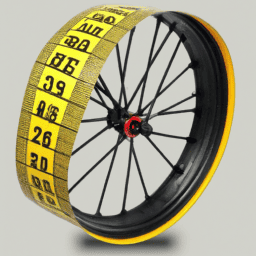Riding a bike, a classic rhythm with the pavement, has always intrigued me. As I explore the realm of bicycles, I am enchanted by the significance of this double-wheeled wonder.
In this article, we will unravel the origins and evolution of bicycles, exploring their impact on transportation, the rise of bicycle advocacy, and the achievements of legendary cyclists.
Join me on this journey as we uncover the fascinating story of what a bicycle truly means.
Key Takeaways
- The term ‘bicycle’ refers to a two-wheeled vehicle used for transportation and has been a popular mode of transportation for centuries.
- The word ‘bicycle’ originated from the Latin word ‘bi’ meaning two and the Greek word ‘kyklos’ meaning circle or wheel. It accurately describes the structure of a bicycle with two wheels.
- Early forms of bicycles, such as the ‘Draisine’ and ‘Boneshaker,’ played a significant role in the development of modern bicycles. Advancements in materials and features have revolutionized the way we ride.
- The bicycle has had a significant impact on transportation, promoting affordability, efficiency, and improved air quality. It also encourages a healthier lifestyle and has cultural and symbolic significance as a symbol of freedom and liberation.
Definition of the term ‘bicycle’
A bicycle is a two-wheeled vehicle that has been a popular mode of transportation for centuries. It is a simple yet efficient means of getting from one place to another. The origins of bicycles can be traced back to the early 19th century when the first prototypes were developed. Over time, these early designs evolved into the modern bicycles we know today. The development of the modern bicycle was greatly influenced by technological advancements and the need for more efficient transportation methods.
The word ‘bicycle’ itself has an interesting origin, which will be discussed in the subsequent section. Now let’s delve into the origins of the word ‘bicycle’ without further ado.
Origins of the word ‘bicycle’
To understand the origins of the word ‘bicycle’, you might want to look into its etymology. The term ‘bicycle’ is derived from the Latin word ‘bi’ meaning two and the Greek word ‘kyklos’ meaning circle or wheel. This accurately describes the basic structure of a bicycle with its two wheels.
The word ‘bicycle’ was first used in English in the mid-19th century, during a time of rapid development and evolution of bicycle design. The origins of the bicycle itself can be traced back even further, with early versions dating back to the 18th century. These early bicycles were often called ‘velocipedes’ or ‘draisines’.
The evolution of bicycle design continued throughout the 19th and 20th centuries, leading to the bicycles we know today. Now, let’s explore the early forms of bicycles and how they laid the foundation for modern designs.
Early forms of bicycles
Explore the early forms of bicycles and how they laid the foundation for modern designs.
Early prototypes of bicycles emerged in the early 19th century, with various inventors and engineers contributing to their development. One of the first significant designs was the ‘Draisine,’ invented by Karl Drais in 1817. It featured a wooden frame, two wheels, and a handlebar for steering.
This invention sparked further innovations, such as the ‘Boneshaker’ in the 1860s, which introduced pedals and a chain drive system. These early forms of bicycles had a historical significance as they paved the way for the development of the modern bicycle we know today.
As we delve into the next section about the development of the modern bicycle, we can see how these early prototypes laid the groundwork for future advancements.
Development of the modern bicycle
The development of the modern bicycle can be traced back to the early prototypes and their influential designs. Over time, advancements in modern bicycle design have revolutionized the way we ride.
The evolution of bicycle materials, such as the introduction of lightweight alloys and carbon fiber, has allowed for greater durability and improved performance. These advancements have also led to the development of specialized bicycles for various activities, including mountain biking and road racing.
Today, modern bicycles are equipped with advanced features like disc brakes, suspension systems, and electronic shifting. These innovations have not only made cycling more enjoyable and efficient but have also contributed to the overall growth of the sport.
As we delve into the impact of the bicycle on transportation, it becomes clear that its influence extends far beyond just recreational use.
Impact of the bicycle on transportation
Imagine how different transportation would be without the bicycle’s influence. The impact of the bicycle on transportation cannot be overstated. Not only has it provided an affordable and efficient mode of transportation for individuals, but it has also had a significant impact on urban congestion. By promoting cycling as a means of transportation, cities have seen a reduction in traffic congestion, leading to improved air quality and overall livability. Additionally, the economic benefits of cycling are substantial. With fewer cars on the road, cities can save on infrastructure costs and allocate resources to other areas. Furthermore, cycling promotes a healthier lifestyle, reducing healthcare costs associated with sedentary lifestyles. As we transition into the subsequent section about the popularity of cycling as a sport, it is clear that the bicycle has shaped transportation in more ways than one.
Popularity of cycling as a sport
The popularity of cycling as a sport has grown significantly in recent years, with more and more people embracing it as a form of exercise and competition. This rise in popularity can be attributed to several factors:
-
Health Benefits: Cycling is a great way to improve cardiovascular fitness, build strength and endurance, and burn calories. It offers a low-impact workout that is gentle on the joints and can be enjoyed by people of all ages and fitness levels.
-
Environmental Impact: With increasing concerns about climate change and pollution, cycling has gained popularity as a sustainable mode of transportation. Many cities have introduced bike-sharing programs and built dedicated cycling infrastructure to encourage more people to take up cycling as a means of commuting.
-
Competitive Thrill: Cycling races and events like the Tour de France and the Olympics have captivated audiences worldwide. The intense competition, strategic teamwork, and incredible athleticism displayed by professional cyclists have inspired many amateurs to take up the sport and challenge themselves.
The popularity of cycling as a sport, coupled with its impact on transportation, highlights the cultural significance of the bicycle as a versatile and beloved mode of transportation.
Cultural significance of the bicycle
In literature and art, the bicycle has often been depicted as a symbol of freedom and liberation. It is seen as a means of escape from the constraints of society, allowing individuals to explore new horizons and experience a sense of independence.
This cultural significance is evident in works such as H.G. Wells’ ‘The Wheels of Chance’ and Henri de Toulouse-Lautrec’s painting ‘The Bicycle.’
Bicycle in literature and art
Bicycle has been a common motif in literature and art. It has captured the imagination of writers and artists throughout history, symbolizing various themes and ideas. Here are three notable examples of the bicycle’s presence in literature and art:
-
In literature, the bicycle often represents freedom and independence. It is a vehicle that allows characters to escape their mundane lives and explore new horizons. From H.G. Wells’ ‘The Wheels of Chance’ to Ernest Hemingway’s ‘The Old Man and the Sea,’ the bicycle serves as a symbol of liberation.
-
In art, the bicycle has been depicted in various forms, from realistic paintings to abstract sculptures. Artists like Marcel Duchamp and Pablo Picasso have incorporated the bicycle into their artworks, showcasing its aesthetic appeal and its ability to inspire creativity.
-
Additionally, the bicycle has been featured in poetry, where it serves as a metaphor for life’s journey. Poets such as E.E. Cummings and John Keats have used the bicycle as a symbol of movement, change, and the passage of time.
As we explore the bicycle’s significance in literature and art, we can see how it transitions into its role as a symbol of freedom in the subsequent section.
Bicycle as a symbol of freedom
Experience the exhilarating sense of liberation that comes from riding a bicycle and feel the wind in your hair as you explore new horizons. The bicycle has long been a symbolic representation of freedom, capturing the imagination of people around the world. Its impact on women’s liberation cannot be understated, as it provided women with a means of transportation and independence. Riding a bicycle gave women the freedom to explore their surroundings, go to work, and participate in activities that were previously inaccessible to them. It became a powerful symbol of empowerment and equality. To evoke emotion in the audience, imagine a table with two columns and four rows. In the first column, write down words like liberation, independence, and empowerment. In the second column, write down words like restriction, limitation, and inequality. This visual representation highlights the stark contrast between the bicycle as a symbol of freedom and the societal constraints it helped to break. As we explore the subsequent section on technological advancements in bicycles, we will see how these advancements further enhanced the freedom and possibilities offered by this remarkable invention.
Technological advancements in bicycles
One of the most notable technological advancements in bicycles is the development of electric motors. This innovation has revolutionized the way people ride and has opened up new possibilities for transportation. Electric motors provide an extra boost of power, making it easier to climb hills and travel longer distances without getting tired.
Additionally, there have been significant technological advancements in bicycle manufacturing, such as the integration of smart technology. This includes features like GPS navigation, built-in lights, and even electronic shifting systems. These advancements not only enhance the riding experience but also improve safety and convenience.
Moving forward, it is important to recognize the environmental benefits of cycling, such as reducing carbon emissions and promoting a healthier lifestyle. By incorporating these advancements, cycling becomes an even more sustainable and efficient mode of transportation.
Environmental benefits of cycling
Now that we have discussed the technological advancements in bicycles, let’s talk about the environmental benefits of cycling.
When it comes to reducing our carbon footprint, cycling is an excellent choice. Not only does it produce zero emissions, but it also helps decrease traffic congestion and noise pollution.
Additionally, cycling promotes a healthier lifestyle by providing a low-impact form of exercise that improves cardiovascular health and strengthens muscles.
Moreover, it offers economic advantages as well. Cycling eliminates the need for expensive fuel and parking fees, making it a cost-effective mode of transportation. By choosing to cycle, individuals can save money while contributing to a cleaner and greener environment.
Speaking of health benefits, let’s delve into the next section and explore the positive impacts of cycling on our well-being.
Health benefits of cycling
Cycling offers numerous health benefits, including improved cardiovascular fitness and strengthened muscles. Regular cycling can help lower the risk of heart disease, stroke, and obesity. It also improves mental well-being by reducing stress and anxiety. Additionally, cycling is a low-impact exercise that puts less strain on joints compared to other forms of physical activity.
To further emphasize the positive impact of cycling, let’s take a look at the table below:
| Health Benefits of Cycling | Environmental Impact | Emotional Response |
|---|---|---|
| Increased stamina | Reduced carbon emissions | Feeling accomplished |
| Weight loss | Preservation of natural resources | Sense of freedom |
| Enhanced lung capacity | Decreased air pollution | Joy and happiness |
| Stronger immune system | Conservation of energy | Pride in eco-friendly choice |
| Improved sleep quality | Decreased noise pollution | Sense of connection with nature |
By considering these health benefits and the positive environmental impact, we can see why cycling is not only beneficial for ourselves but also for the planet. Now, let’s move on to safety tips for cycling.
Safety tips for cycling
When it comes to cycling, there are a few key safety tips that I always keep in mind.
First and foremost, wearing a helmet is of utmost importance. It can protect your head in case of an accident and prevent serious injuries.
Additionally, obeying traffic rules and signals is crucial for both your safety and the safety of others on the road. It helps to ensure a smooth flow of traffic and reduces the risk of accidents.
Overall, by following these safety measures, we can enjoy our cycling experiences while minimizing the chances of any mishaps.
Importance of wearing helmets
Make sure you’re wearing a helmet while riding a bike. Helmets are crucial for protecting your head and preventing serious injuries in case of accidents. When choosing a helmet, look for designs that provide maximum coverage and a secure fit. It should meet the necessary safety standards to ensure proper protection.
Here are some important reasons why wearing a helmet is essential:
-
Protection: Helmets protect your head from impact and reduce the risk of traumatic brain injuries.
-
Visibility: Some helmets come with reflective elements that enhance visibility, making you more visible to motorists.
-
Comfort: Modern helmets are designed to be lightweight and well-ventilated, ensuring comfort during long rides.
-
Style: There are various helmet designs available, allowing you to express your personal style while staying safe.
-
Children’s safety: Encourage children to wear helmets from an early age to develop a lifelong habit of bike safety.
Remember, wearing a helmet is just one aspect of bike safety. Obeying traffic rules and signals is equally important.
Obeying traffic rules and signals
Transitioning from the importance of wearing helmets, let’s now discuss the significance of obeying traffic rules and signals while riding a bicycle. As a cyclist, it is crucial to adhere to these regulations to ensure your safety and the safety of others on the road. By following traffic rules, such as stopping at red lights and yielding to pedestrians, we can minimize the risk of accidents and maintain order on the streets. Additionally, obeying traffic rules promotes a sense of awareness and responsibility. It helps us stay alert and focused on our surroundings, enabling us to anticipate potential hazards and react accordingly. Remember, being a law-abiding cyclist not only protects you but also contributes to a harmonious coexistence with other road users. Now, let’s explore the next section about bicycle advocacy and infrastructure, where we will delve into the efforts to create a more bicycle-friendly environment.
Bicycle advocacy and infrastructure
Bicycle advocacy and infrastructure have greatly improved in many cities. Governments and organizations are recognizing the benefits of promoting cycling as a sustainable mode of transportation. They have invested in creating dedicated bicycle lanes, improving existing infrastructure, and implementing bike-sharing programs. These initiatives not only encourage more people to cycle but also ensure their safety on the roads.
Bicycle infrastructure includes bike lanes, bike racks, and bike-friendly parking areas. It also involves educating drivers about sharing the road with cyclists and creating awareness campaigns to promote cycling as a viable transportation option. With these improvements, more people are choosing to cycle, leading to reduced traffic congestion, improved air quality, and better overall health.
Transitioning into the subsequent section about famous cyclists and their achievements, these advancements have paved the way for remarkable feats in the world of cycling.
Famous cyclists and their achievements
You may be amazed by the accomplishments of famous cyclists and what they have achieved. Here are four remarkable achievements by some of the most renowned cyclists in history:
-
Eddy Merckx: Known as ‘The Cannibal,’ Merckx won a record-breaking 11 Grand Tours and holds the most victories in one-day classics. His dominance in the 1960s and 1970s solidified his status as one of the greatest cyclists of all time.
-
Lance Armstrong: Despite controversy surrounding his career, Armstrong won the Tour de France a record-breaking seven consecutive times from 1999 to 2005. He inspired many with his victorious battles against cancer and subsequent success in cycling.
-
Chris Hoy: This British cyclist won six Olympic gold medals, making him one of the most successful Olympic cyclists in history. His dominance in track cycling earned him the nickname ‘The Real McHoy.’
-
Marianne Vos: With numerous world titles and Olympic gold medals, Vos is considered the most versatile female cyclist in the world. Her achievements span road racing, cyclo-cross, and track events, making her an icon in the sport.
These incredible achievements by famous cyclists showcase the extraordinary talents and dedication of these athletes.
Now, let’s delve into some interesting facts about bicycles.
Interesting facts about bicycles
Get ready to discover some fascinating facts about bikes!
Bicycles have a rich history, with several key inventions shaping their development. The first recognizable bicycle, known as the ‘Dandy Horse,’ was created in 1817 by Karl Drais. However, it wasn’t until the 1860s that the pedal-driven bicycle we know today was invented by Pierre Michaux.
Did you know that bicycles played a significant role in the women’s liberation movement? They provided women with a newfound sense of freedom and independence.
Today, bicycles are the most common mode of transportation in the world, with over a billion bicycles worldwide. They are not only an eco-friendly alternative but also a great way to stay fit and explore the outdoors.
As we move forward, the future of bicycles holds exciting possibilities for innovative designs and advanced technologies. Transitioning into the next section, let’s explore the conclusion and future of bicycles.
Conclusion and future of bicycles
Moving forward, the future of bikes looks promising with innovative designs and advanced technologies on the horizon.
As more cities prioritize sustainability and improve their cycling infrastructure, bicycles are becoming an integral part of urban planning.
With the increasing popularity of e-bikes, we can expect to see more efficient and eco-friendly transportation options in the future. These electric bikes not only reduce our carbon footprint but also make cycling more accessible to a wider range of individuals.
Additionally, the integration of smart technologies into bikes, such as GPS navigation and safety features, will further enhance the cycling experience.
The future of bicycles holds great potential to revolutionize urban transportation, promote healthier lifestyles, and create more livable cities.
Frequently Asked Questions
What are the different types of bicycles available in the market today?
There are various types of bicycles available in the market today, each designed for different purposes such as road biking, mountain biking, and commuting. Cycling offers numerous benefits like improved fitness, reduced carbon footprint, and cost savings on transportation.
How do I choose the right size bicycle for myself?
When choosing the right bicycle size, consider factors such as your height, inseam length, and riding style. It’s important to have a comfortable fit for better control and efficiency while riding.
Are there any specific rules or regulations for cycling on the road?
Cycling on the road requires following specific rules and regulations to ensure safety. It’s like navigating a well-constructed bike path, with proper cycling infrastructure in place to protect both riders and motorists.
What are some common maintenance tips for keeping a bicycle in good condition?
To keep a bicycle in good condition, regular maintenance is essential. Some common maintenance tips include checking tire pressure, lubricating the chain, inspecting brakes, and keeping the bike clean. Bicycle repair shops can also provide professional assistance.
How has the bicycle industry evolved over time in terms of design and materials used?
Over time, the bicycle industry has seen remarkable evolution in terms of design and materials. The emergence of carbon fiber has had a profound impact on bicycle technology, revolutionizing bike design with its lightweight and durable properties.
Conclusion
In conclusion, the bicycle is not just a mode of transportation, but a revolutionary invention that has transformed the way we travel.
Its origins may seem humble, but the impact it has had on society is enormous. From its early forms to the modern sleek designs, the bicycle has constantly evolved, making it a symbol of progress and innovation.
With its ability to reduce traffic congestion and carbon emissions, it has become a champion for sustainable transportation.
The future of bicycles looks bright, as more people recognize its benefits and embrace the cycling culture.
















